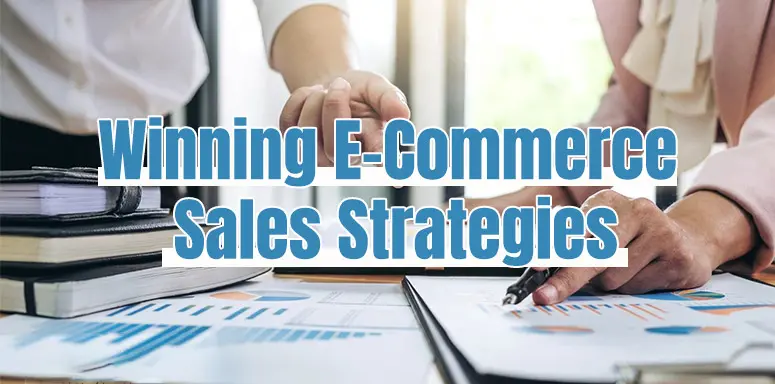
In today’s digital age, having a strong online presence is crucial for the success of any business, especially those in the e-commerce industry. However, simply having an online store is not enough to guarantee success. To truly thrive in the competitive world of e-commerce, businesses need to have a well-thought-out sales strategy that is tailored to their specific target audience and business goals.
In this blog post, we will be discussing how to build a winning e-commerce sales strategy for your business. We will be sharing tips and best practices for optimizing your website, developing a content marketing strategy, investing in search engine optimization (SEO), utilizing paid advertising, and offering incentives and discounts. By the end of this post, you will have a better understanding of how to create a comprehensive e-commerce sales strategy that will help you attract and retain customers, increase conversions, and ultimately drive revenue for your business. So, let’s dive in!
1. Know Your Target Audience

One of the most important aspects of building a successful e-commerce sales strategy is understanding your target audience. By understanding their needs, interests, and pain points, you can create a more effective marketing message and tailor your offerings to meet their specific needs. Here are some tips for conducting audience research:
Use social media: Social media platforms like Facebook, Twitter, and Instagram are great sources of information about your target audience. Look at the types of content they engage with and what they’re saying in the comments to gain insights into their interests and preferences.
Collect customer feedback: Ask your existing customers for feedback on their experiences with your products and services. This will help you identify areas where you can improve and also give you a better understanding of what your customers value most.
Conduct surveys: Surveys are a great way to gather information about your target audience. Use tools like SurveyMonkey or Google Forms to create surveys that ask about their interests, pain points, and purchasing habits.
By taking the time to understand your target audience, you can create a more effective e-commerce sales strategy that speaks directly to their needs and interests. This will help you build stronger relationships with your customers, increase customer loyalty, and ultimately drive more sales for your business.
2. Optimize Your Website
Once you have a good understanding of your target audience, the next step in building a winning e-commerce sales strategy is to optimize your website. Your website is your online storefront, and it’s important that it’s user-friendly and visually appealing in order to attract and retain customers. Here are some tips for optimizing your website:
Improve load times: Slow website load times can lead to high bounce rates, which can negatively impact your search engine rankings and customer experience. Use tools like Google PageSpeed Insights to identify and fix issues that may be slowing down your website.
Make it mobile-friendly: With more and more people using their mobile devices to browse and shop online, it’s essential that your website is mobile-friendly. Make sure your website is optimized for mobile devices with responsive design and easy navigation.
Have clear calls to action: Your website should have clear and concise calls to action (CTAs) that tell customers what you want them to do next. Use action-oriented language and design your CTAs to stand out on your website.
Use high-quality visuals: Use high-quality images and videos on your website to showcase your products and services. This can help customers get a better sense of what they’re buying and make them more likely to make a purchase.
By optimizing your website, you can create a better user experience for your customers and increase your chances of making a sale. Take the time to review your website regularly and make updates as needed to ensure it’s always up to date and working at its best.
3. Develop a Content Marketing Strategy

Content marketing is a powerful tool for e-commerce businesses. By creating valuable content that educates and entertains your target audience, you can attract and retain customers, build brand awareness, and ultimately drive sales. Here are some tips for developing a content marketing strategy:
Create a blog: Creating a blog on your website is a great way to share valuable content with your audience. Use your blog to write about topics related to your products or services, share industry news and insights, and provide tips and tutorials.
Use social media: Social media platforms like Facebook, Twitter, and Instagram are great channels for sharing your content and reaching a wider audience. Use each platform to share content that’s tailored to the specific audience and format of that platform.
Use video: Video is becoming an increasingly popular format for content marketing. Create videos that showcase your products, provide how-to tutorials, or share behind-the-scenes glimpses of your business.
Be consistent: Consistency is key when it comes to content marketing. Create a content calendar and stick to it, so your audience knows when to expect new content from you.
By developing a content marketing strategy, you can build a loyal following of customers who trust and value your brand. Keep in mind that creating valuable content takes time and effort, but the payoff can be significant in terms of increased traffic, leads, and sales.
4. Invest in Search Engine Optimization (SEO)
Search engine optimization (SEO) is the process of optimizing your website and content to rank higher in search engine results pages (SERPs). By ranking higher in search results, you can attract more organic traffic to your website and increase your chances of making a sale. Here are some tips for investing in SEO:
Conduct keyword research: Keyword research is the process of identifying the search terms your target audience is using to find businesses like yours. Use tools like Google Keyword Planner or SEMrush to identify high-volume, low-competition keywords to target in your content.
Optimize your website: Use on-page optimization techniques like including keywords in your page titles, meta descriptions, and alt tags. Make sure your website is structured and organized in a way that’s easy for search engines to crawl and index.
Build high-quality backlinks: Backlinks are links from other websites to your website. They’re a key factor in search engine rankings, so it’s important to build high-quality backlinks from reputable websites in your industry.
Monitor and analyze your results: Use tools like Google Analytics and Google Search Console to monitor your website traffic and search engine rankings. Analyze your results and make adjustments to your SEO strategy as needed.
Investing in SEO can take time and effort, but the payoff can be significant in terms of increased traffic and sales. Keep in mind that SEO is an ongoing process, and it’s important to stay up to date with best practices and algorithm updates to maintain your rankings over time.
5. Utilize Paid Advertising
Paid advertising is another effective way to drive traffic and sales for your e-commerce business. Here are some tips for utilizing paid advertising:
Choose the right platform: Consider which advertising platform is best for your business. Google Ads is a popular option for search advertising, while social media platforms like Facebook and Instagram are great for targeting specific audiences.
Set a budget: Determine how much you’re willing to spend on advertising and set a budget accordingly. Start with a small budget and adjust as you see results.
Target your audience: Use targeting options to ensure your ads are reaching the right audience. For example, you can target by demographics, interests, or behaviors.
Create compelling ad content: Use attention-grabbing headlines, compelling images or videos, and clear calls to action to encourage clicks and conversions.
Monitor and analyze your results: Use analytics tools to track your advertising performance and make adjustments to your strategy as needed.
Paid advertising can be a powerful way to drive traffic and sales for your e-commerce business. Keep in mind that it can be competitive, so it’s important to continually test and refine your strategy to stay ahead of the competition.
6. Offer Incentives and Discounts

Offering incentives and discounts can be a powerful way to attract new customers and drive sales for your e-commerce business. Here are some tips for offering incentives and discounts:
Set clear goals: Determine what you want to achieve with your incentives and discounts, such as attracting new customers or boosting sales of a specific product.
Choose the right incentive: Consider which incentives will be most appealing to your target audience. Some options include free shipping, discount codes, buy-one-get-one offers, or loyalty programs.
Use scarcity: Create a sense of urgency by offering limited-time deals or limited quantities of products. This can encourage customers to act quickly and make a purchase.
Promote your incentives: Use your website, social media, and email marketing to promote your incentives and discounts. Make sure to provide clear instructions for how to redeem them.
Measure your results: Use analytics tools to track the performance of your incentives and discounts. This can help you determine which strategies are most effective and make adjustments to your strategy as needed.
By offering incentives and discounts, you can attract new customers and encourage repeat purchases from existing customers. Keep in mind that it’s important to strike a balance between offering incentives and maintaining profitability for your business.
Final words
In today’s digital age, e-commerce businesses have more opportunities than ever to reach and engage with their target audience. By utilizing the tips and strategies outlined in this article, you can build a winning e-commerce sales strategy that helps you stand out from the competition, drive traffic and sales, and build long-term customer loyalty.
Remember to continually evaluate and refine your approach based on customer feedback and analytics data, and don’t be afraid to experiment with new tactics and technologies. With dedication and perseverance, you can achieve e-commerce success and take your business to the next level.